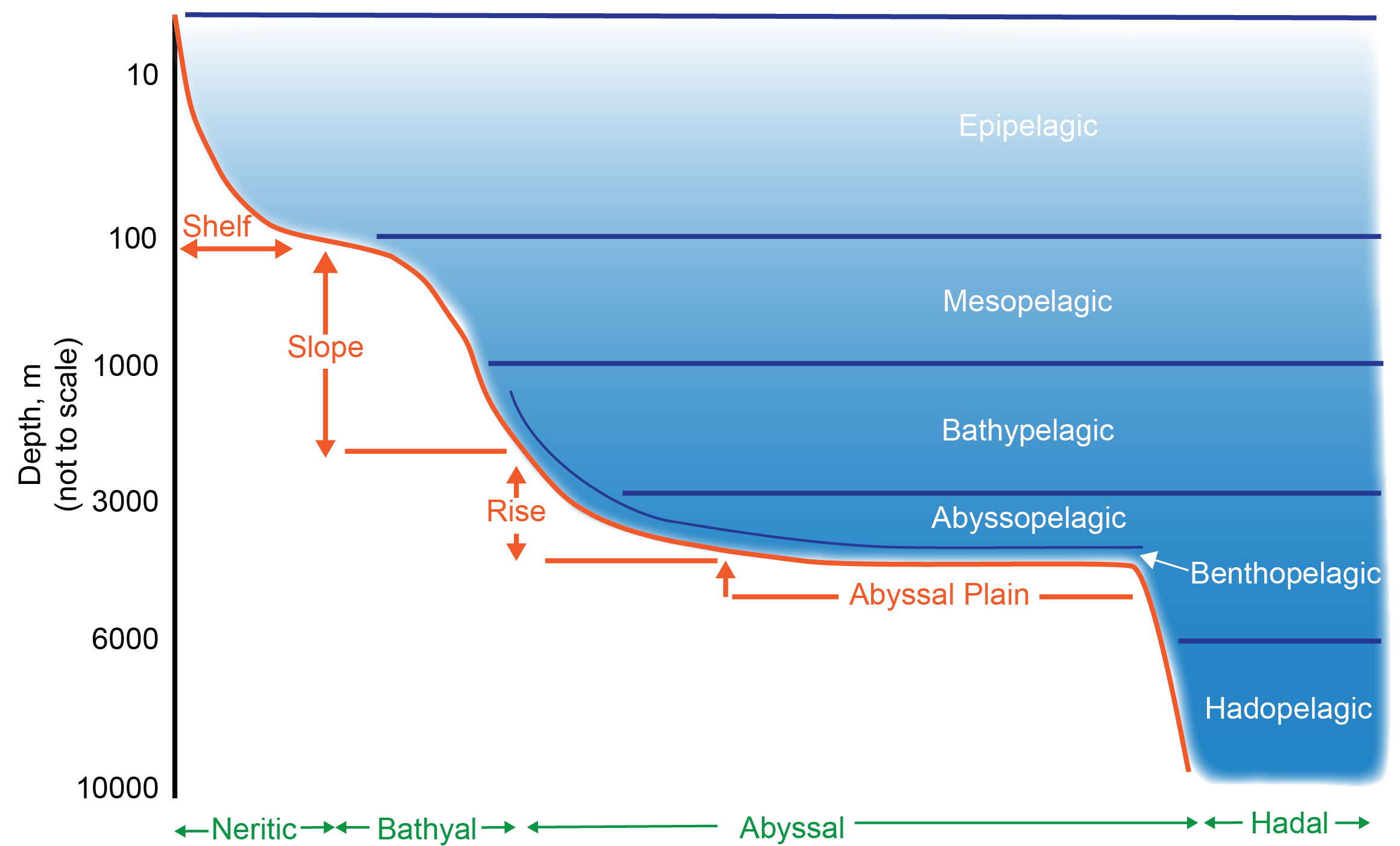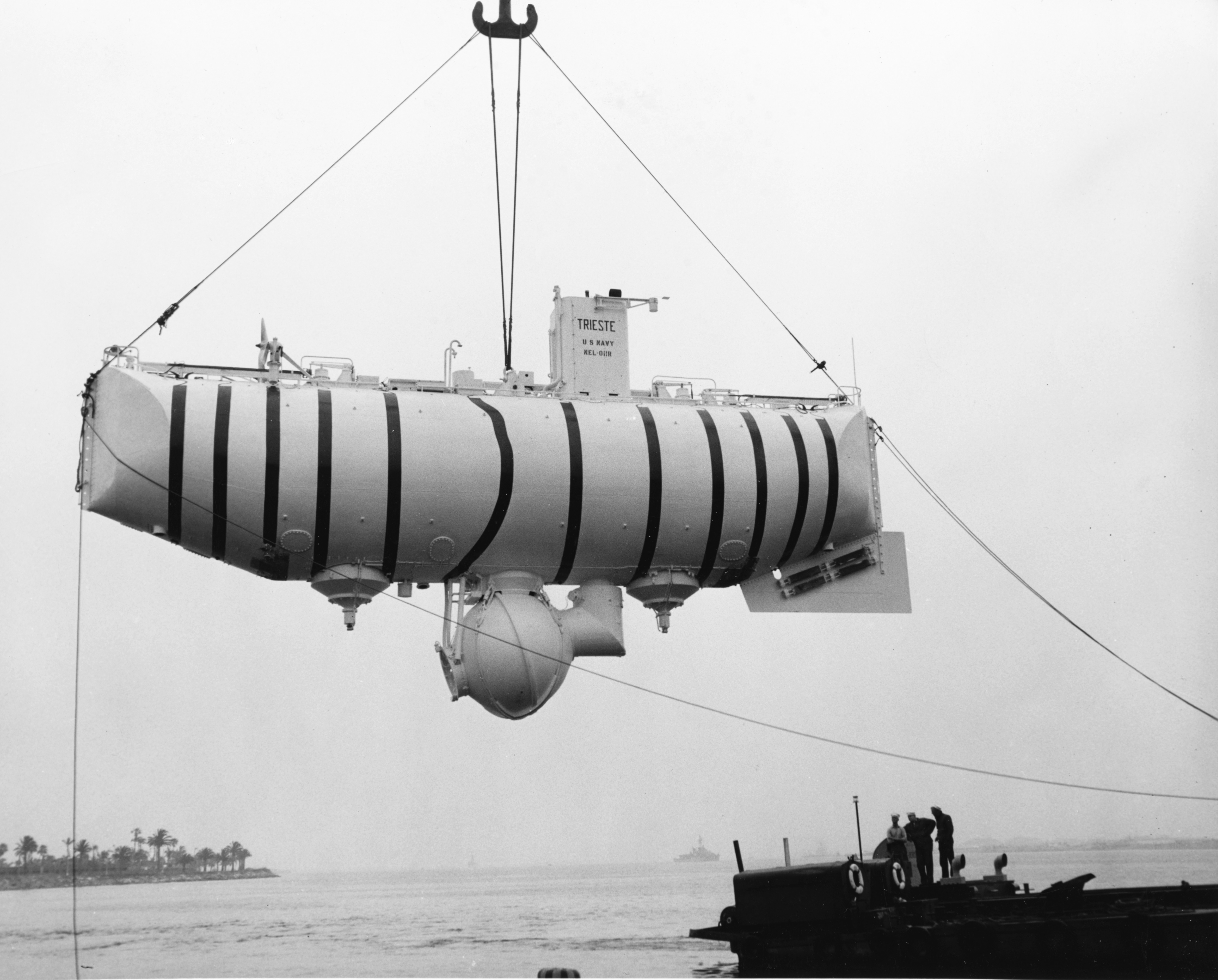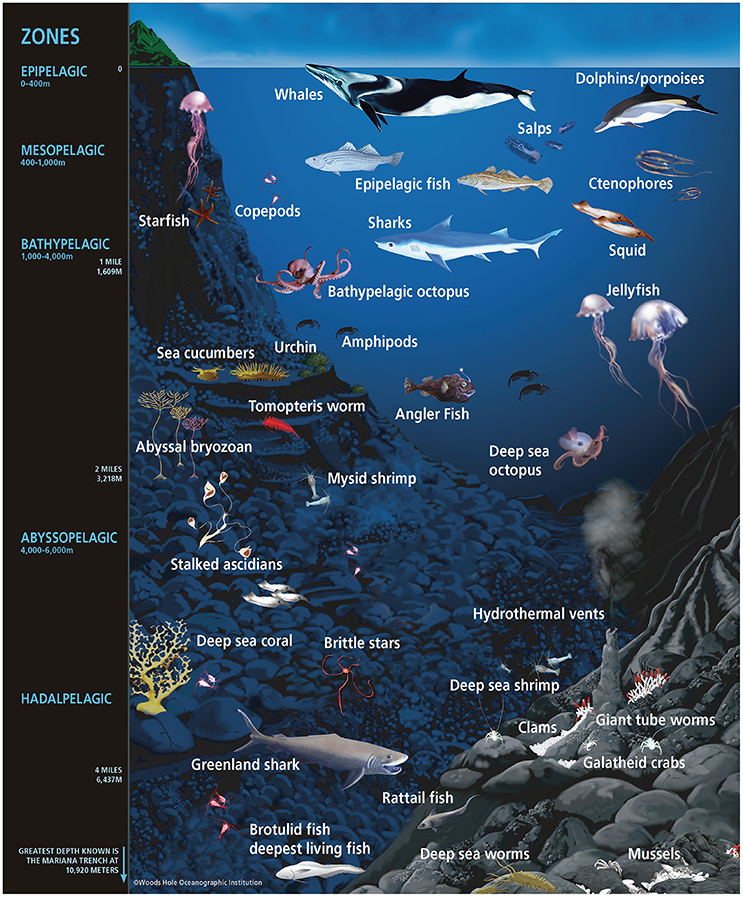|
Deep-sea
The deep sea is broadly defined as the ocean depth where light begins to fade, at an approximate depth of 200 metres (656 feet) or the point of transition from continental shelves to continental slopes. Conditions within the deep sea are a combination of low temperatures, darkness and high pressure The deep sea is considered the least explored Earth biome, with the extreme conditions making the environment difficult to access and explore. Organisms living within the deep sea have a variety of adaptations to survive in these conditions. Organisms can survive in the deep sea through a number of feeding methods including scavenging, predation and filtration, with a number of organisms surviving by feeding on marine snow. Marine snow is organic material that has fallen from upper waters into the deep sea. In 1960, the bathyscaphe ''Trieste'' descended to the bottom of the Mariana Trench near Guam, at , the deepest known spot in any ocean. If Mount Everest () were submerged there, its ... [...More Info...] [...Related Items...] OR: [Wikipedia] [Google] [Baidu] |
Challenger Deep
The Challenger Deep is the deepest-known point of the seabed of Earth, with a depth of by direct measurement from deep-diving submersibles, remotely operated underwater vehicles and benthic landers, and (sometimes) slightly more by sonar bathymetry. The Challenger Deep is located in the western Pacific Ocean, at the southern end of the Mariana Trench, near the Mariana Islands. According to the August 2011 version of the GEBCO Gazetteer of Undersea Feature Names, the Challenger Deep is deep at . This location is in the ocean territory of the Federated States of Micronesia. The depression is named after the British Royal Navy survey ship , whose expedition of 1872–1876 made the first recordings of its depth. The high water pressure at this depth makes designing and operating exploratory craft difficult. The first descent by any vehicle was by Jacques Piccard and Don Walsh in the manned bathyscaphe ''Trieste'' in January 1960; unmanned visits followed in 1996, 1998 and 2009. ... [...More Info...] [...Related Items...] OR: [Wikipedia] [Google] [Baidu] |
Bathyal Zone
The bathypelagic zone or bathyal zone (from Greek βαθύς (bathýs), deep) is the part of the open ocean that extends from a depth of below the ocean surface. It lies between the mesopelagic above, and the abyssopelagic below. The bathypelagic is known as the midnight zone because of the lack of sunlight; this feature does not allow for photosynthesis-driven primary production, preventing growth of phytoplankton or aquatic plants. Although larger by volume than the photic zone, our knowledge of the bathypelagic zone remains limited by our ability to explore the deep ocean. Physical characteristics The bathypelagic zone is characterized by a nearly constant temperature of approximately and a salinity range of 33-35 g/kg. This region has little to no light, because sunlight does not reach this deep in the ocean and bioluminescence is limited. The hydrostatic pressure in this zone ranges 100-400 atmospheres (atm), due to the increase of 1 atm for every 10 m depth. It is bel ... [...More Info...] [...Related Items...] OR: [Wikipedia] [Google] [Baidu] |
Abyssal Zone
The abyssal zone or abyssopelagic zone is a layer of the pelagic zone of the ocean. "Abyss" derives from the Greek word , meaning bottomless. At depths of , this zone remains in perpetual darkness. It covers 83% of the total area of the ocean and 60% of Earth's surface. The abyssal zone has temperatures around through the large majority of its mass. Due to there being no light, there are no plants producing oxygen, which instead primarily comes from ice that had melted long ago from the polar regions. The water along the seafloor of this zone is actually devoid of oxygen, resulting in a death trap for organisms unable to quickly return to the oxygen-enriched water above. This region also contains a much higher concentration of nutrient salts, like nitrogen, phosphorus, and silica, due to the large amount of dead organic material that drifts down from the above ocean zones and decomposes. The water pressure can reach up to 76 megapascal. The area below the abyssal zone is the sp ... [...More Info...] [...Related Items...] OR: [Wikipedia] [Google] [Baidu] |
Mesopelagic
The mesopelagic zone (Greek μέσον, middle), also known as the middle pelagic or twilight zone, is the part of the pelagic zone that lies between the photic epipelagic and the aphotic bathypelagic zones. It is defined by light, and begins at the depth where only 1% of incident light reaches and ends where there is no light; the depths of this zone are between approximately 200 to 1,000 meters (~656 to 3,280 feet) below the ocean surface. The mesopelagic zone occupies about 60% of the planet's surface and about 20% of the ocean's volume, amounting to a large part of the total biosphere. It hosts a diverse biological community that includes bristlemouths, blobfish, bioluminescent jellyfish, giant squid, and a myriad of other unique organisms adapted to live in a low-light environment. It has long captivated the imagination of scientists, artists and writers; deep sea creatures are prominent in popular culture. Physical conditions The mesopelagic zone includes the reg ... [...More Info...] [...Related Items...] OR: [Wikipedia] [Google] [Baidu] |
Mariana Trench
The Mariana Trench is an oceanic trench located in the western Pacific Ocean, about east of the Mariana Islands; it is the deepest oceanic trench on Earth. It is crescent-shaped and measures about in length and in width. The maximum known depth is at the southern end of a small slot-shaped valley in its floor known as the Challenger Deep. If Mount Everest were hypothetically placed into the trench at this point, its peak would still be underwater by more than . At the bottom of the trench, the water column above exerts a pressure of , more than 1,071 times the standard atmospheric pressure at sea level. At this pressure, the density of water is increased by 4.96%. The temperature at the bottom is . In 2009, the Mariana Trench was established as a US National Monument. Monothalamea have been found in the trench by Scripps Institution of Oceanography researchers at a record depth of below the sea surface. Data has also suggested that microbial life forms thrive withi ... [...More Info...] [...Related Items...] OR: [Wikipedia] [Google] [Baidu] |
Marine Snow
In the deep ocean, marine snow (also known as "ocean dandruff") is a continuous shower of mostly organic detritus falling from the upper layers of the water column. It is a significant means of exporting energy from the light-rich photic zone to the aphotic zone below, which is referred to as the biological pump. Export production is the amount of organic matter produced in the ocean by primary production that is not recycled ( remineralised) before it sinks into the aphotic zone. Because of the role of export production in the ocean's biological pump, it is typically measured in units of carbon (e.g. mg C m−2 d−1). The term was first coined by the explorer William Beebe as he observed it from his bathysphere. As the origin of marine snow lies in activities within the productive photic zone, the prevalence of marine snow changes with seasonal fluctuations in photosynthetic activity and ocean currents. Marine snow can be an important food source for organisms living in th ... [...More Info...] [...Related Items...] OR: [Wikipedia] [Google] [Baidu] |
Bathyscaphe
A bathyscaphe ( or ) is a free-diving self-propelled deep-sea submersible, consisting of a crew cabin similar to a bathysphere, but suspended below a float rather than from a surface cable, as in the classic bathysphere design. The float is filled with gasoline because it is readily available, buoyant, and, for all practical purposes, incompressible. The incompressibility of the gasoline means the tanks can be very lightly constructed, since the pressure inside and outside the tanks equalises, eliminating any differential. By contrast, the crew cabin must withstand a huge pressure differential and is massively built. Buoyancy at the surface can be trimmed easily by replacing gasoline with water, which is denser. Auguste Piccard, inventor of the first bathyscaphe, composed the name ''bathyscaphe'' using the Ancient Greek words βαθύς ''bathys'' ("deep") and σκάφος ''skaphos'' ("vessel"/"ship"). Mode of operation To descend, a bathyscaphe floods air tanks with se ... [...More Info...] [...Related Items...] OR: [Wikipedia] [Google] [Baidu] |
Nereus (underwater Vehicle)
''Nereus'' was a hybrid uncrewed autonomous underwater vehicle (HROV, a type of remotely operated underwater vehicle) built by the Woods Hole Oceanographic Institution (WHOI). Constructed as a research vehicle to operate at depths of up to , it was designed to explore Challenger Deep, the deepest surveyed point in the global ocean. ''Nereus'', named for Greek sea titan Nereus (who has a man's torso and a fish-tail) through a nationwide contest of high school and college students, began its deep sea voyage to Challenger Deep in May 2009 and reached the bottom on May 31, 2009. On this dive the ''Nereus'' reached a depth of , making the ''Nereus'' the world's deepest-diving vehicle in operation at the time, and the first since 1998 to explore the Mariana Trench, the deepest known part of the ocean. On 10 May 2014, ''Nereus'' was lost while exploring the Kermadec Trench at a depth of . Communications were cut off at around 2 p.m. local time, and debris retrieved later revealed that i ... [...More Info...] [...Related Items...] OR: [Wikipedia] [Google] [Baidu] |
Pelagic Zone
The pelagic zone consists of the water column of the open ocean, and can be further divided into regions by depth (as illustrated on the right). The word ''pelagic'' is derived . The pelagic zone can be thought of as an imaginary cylinder or water column between the surface of the sea and the bottom. Conditions in the water column change with depth: pressure increases; temperature and light decrease; salinity, oxygen, micronutrients (such as iron, magnesium and calcium) all change. Marine life is affected by bathymetry (underwater topography) such as the seafloor, shoreline, or a submarine seamount, as well as by proximity to the boundary between the ocean and the atmosphere at the ocean surface, which brings light for photosynthesis, predation from above, and wind stirring up waves and setting currents in motion. The pelagic zone refers to the open, free waters away from the shore, where marine life can swim freely in any direction unhindered by topographical constraints. Th ... [...More Info...] [...Related Items...] OR: [Wikipedia] [Google] [Baidu] |
Polar Regions Of Earth
The polar regions, also called the frigid geographical zone, zones or polar zones, of Earth are the regions of the planet that surround its geographical poles (the North Pole, North and South Poles), lying within the polar circles. These high latitudes are dominated by floating Arctic ice pack, sea ice covering much of the Arctic Ocean in the north, and by the Antarctic ice sheet on the continent of Antarctica and the Southern Ocean in the south. Definitions The Arctic has various definitions, including the region north of the Arctic Circle (currently Epoch 2010 at 66°33'44" N), or just the region north of 60th parallel north, 60° north latitude, or the region from the North Pole north to the Tree line, timberline. The Antarctic is usually defined simply as south of 60th parallel south, 60° south latitude, or the continent of Antarctica. The 1959 Antarctic Treaty System, Antarctic Treaty uses the former definition. The two polar regions are distinguished from the other two c ... [...More Info...] [...Related Items...] OR: [Wikipedia] [Google] [Baidu] |
Continental Slope
A continental margin is the outer edge of continental crust abutting oceanic crust under coastal waters. It is one of the three major zones of the ocean floor, the other two being deep-ocean basins and mid-ocean ridges. The continental margin consists of three different features: the continental rise, the continental slope, and the continental shelf. The continental shelf is the relatively shallow water area found in proximity to continents. Continental margins constitute about 28% of the oceanic area. Zones of the continental margin The continental shelf is the portion of the continental margin that transitions from the shore out towards to ocean. Continental shelves are believed to make up 7% of the sea floor. The width of continental shelves worldwide varies in the range of 0.03–1500 km. The continental shelf is generally flat, and ends at the shelf break, where there is a drastic increase in slope angle: The mean angle of continental shelves worldwide is 0° 07′, and ... [...More Info...] [...Related Items...] OR: [Wikipedia] [Google] [Baidu] |
Ingeniøren
''Ingeniøren'' (full name: ''Nyhedsmagasinet Ingeniøren'', literally ''The News Magazine "The Engineer"'') is a Danish weekly newspaper specialising in engineering topics. History and profile The paper has covered science and technology issues as well as political topics and debate related to engineering since 1892, and maintains an online archive of these. The online version began 2 December 1994, as the first Danish internet media.Behrendt, Maria.Ing.dk kom først – lige fra den spæde start ''Ingeniøren'', 24 December 2014. Retrieved 24 December 2014. Corresponding publications are ''Ny Teknik'' in Sweden, ''Teknisk Ukeblad'' in Norway and ''Technisch Weekblad'' in the Netherlands ) , anthem = ( en, "William of Nassau") , image_map = , map_caption = , subdivision_type = Sovereign state , subdivision_name = Kingdom of the Netherlands , established_title = Before independence , established_date = Spanish Netherl .... References External links * {{DEFAU ... [...More Info...] [...Related Items...] OR: [Wikipedia] [Google] [Baidu] |








